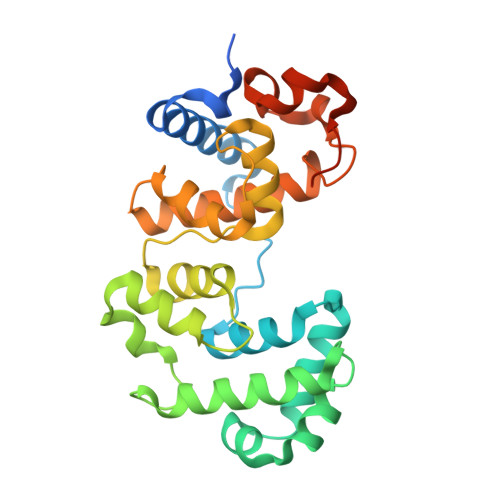Structural and Functional Characterization of Two Unusual Endonuclease III Enzymes from Deinococcus Radiodurans.
Sarre, A., Okvist, M., Klar, T., Hall, D.R., Smalas, A.O., Mcsweeney, S., Timmins, J., Moe, E.(2015) J Struct Biol 191: 87
- PubMed: 26172070
- DOI: https://doi.org/10.1016/j.jsb.2015.05.009
- Primary Citation of Related Structures:
4UNF, 4UOB - PubMed Abstract:
While most bacteria possess a single gene encoding the bifunctional DNA glycosylase Endonuclease III (EndoIII) in their genomes, Deinococcus radiodurans possesses three: DR2438 (DrEndoIII1), DR0289 (DrEndoIII2) and DR0982 (DrEndoIII3). Here we have determined the crystal structures of DrEndoIII1 and an N-terminally truncated form of DrEndoIII3 (DrEndoIII3Δ76). We have also generated a homology model of DrEndoIII2 and measured activity of the three enzymes. All three structures consist of two all α-helical domains, one of which exhibits a [4Fe-4S] cluster and the other a HhH-motif, separated by a DNA binding cleft, similar to previously determined structures of endonuclease III from Escherichia coli and Geobacillus stearothermophilus. However, both DrEndoIII1 and DrEndoIII3 possess an extended HhH motif with extra helical features and an altered electrostatic surface potential. In addition, the DNA binding cleft of DrEndoIII3 seems to be less accessible for DNA interactions, while in DrEndoIII1 it seems to be more open. Analysis of the enzyme activities shows that DrEndoIII2 is most similar to the previously studied enzymes, while DrEndoIII1 seems to be more distant with a weaker activity towards substrate DNA containing either thymine glycol or an abasic site. DrEndoIII3 is the most distantly related enzyme and displays no detectable activity towards these substrates even though the suggested catalytic residues are conserved. Based on a comparative structural analysis, we suggest that the altered surface potential, shape of the substrate-binding pockets and specific amino acid substitutions close to the active site and in the DNA interacting loops may underlie the unexpected differences in activity.
- The Norwegian Structural Biology Centre (NorStruct), Department of Chemistry, UiT the Arctic University of Norway, N-9037 Tromsø, Norway.
Organizational Affiliation:



















